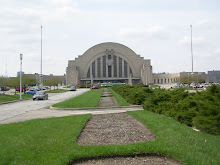Bartholomew County Courthouse

First Christian Church
 Completed in 1942, the Eliel Saarinen designed church may not look like much from the outside but the interiors and the play of light are fantastic. It is a National Historic Landmark.
Completed in 1942, the Eliel Saarinen designed church may not look like much from the outside but the interiors and the play of light are fantastic. It is a National Historic Landmark.Mill Race Park
 One of the coolest city parks.
One of the coolest city parks.First Baptist Church
 Completed in 1965, this church is by Harry Weese and quite wonderful. Some nice person let me in to snoop around . . . Also a National Historic Landmark.
Completed in 1965, this church is by Harry Weese and quite wonderful. Some nice person let me in to snoop around . . . Also a National Historic Landmark.North Christian Church
 Completed in 1964 and designed by Eero Saarinen this too is a National Historic Landmark. The grounds are pretty nice but the interior was my least favorite of the three churches.
Completed in 1964 and designed by Eero Saarinen this too is a National Historic Landmark. The grounds are pretty nice but the interior was my least favorite of the three churches.Irwin Union Bank and Trust
 Yet another National Historic Landmark. This one was also designed by Eero, completed in 1954. Some point to it as the first bank with glass walls and an open plan.
Yet another National Historic Landmark. This one was also designed by Eero, completed in 1954. Some point to it as the first bank with glass walls and an open plan.The Republic

Bartholomew County Veterans Memorial

Author's Note: Baedeker was a German-based travel guide begun in 1827 by Karl Baedeker. These comprehensive guides were hugely popular in Europe, the United States, and throughout the British Empire. I have adopted the moniker for all my travel pieces beyond Cincinnati. Given its German history and stately influence, I thought it fitting for the Queen City.
.jpg)

No comments:
Post a Comment